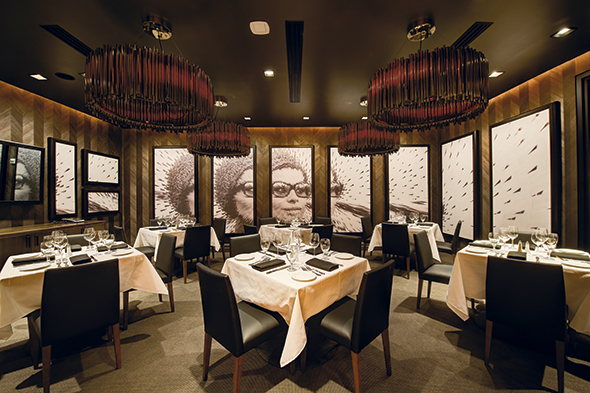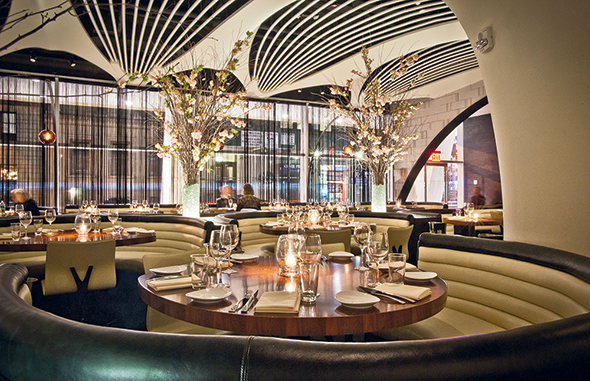A bright spot in the volatile foodservice industry, fine dining now features broader menu offerings and less stuffy service.
The fine-dining segment has, for the most part, been fortunate in comparison to other restaurant types. Fine dining has the benefit of being insulated from economic influences, as consumers tap into these operations for splurges, celebrations, corporate entertaining and other occasions.
 Ocean Prime
Ocean Prime
A Business Insider report notes because these restaurants offer a more experience-based dining proposition for a less price-sensitive consumer, folks with money continue to spend at fine-dining establishments.
As of October 2016, the last period for which this data is available, there were more than 5,100 fine-dining restaurants in the U.S. with check averages more than $50, according to Chicago-based research firm CHD Expert North America. Fine-dining restaurants make up 1.4 percent of America's full-service restaurant landscape and account for 0.73 percent of the total restaurant landscape. In terms of the breakdown, steak and seafood menu types make up 21 percent of the fine-dining segment, while family steak/chophouse accounts for 20 percent and American traditional makes up 16 percent.
When it comes to annual sales, the fine-dining segment rakes in more than $10 billion in sales, with an average unit volume of almost $2 million per unit, per CHD Expert's data. In comparison to the rest of the industry, all full-service restaurants average $824,000 in revenue per unit per year. Only 8 percent of fine-dining restaurants gross more than $5 million in annual sales.
While some fine-dining chain restaurants have become household names, 88 percent are considered independent operators with nine or fewer units, reports CHD Expert.
A Segment Evolving
A scaled down version of fine dining continues to emerge, drawing on many of the hallmarks of the fast-casual segment. This trend makes a lot of sense from an operational perspective, as rising U.S. labor costs and the higher prices of dining out place pressure on operators to streamline costs, says Amanda Topper, associate director of foodservice research for Mintel. "By simplifying or automating the ordering process, more attention and resources can be directed toward obtaining quality ingredients and menu item execution. Additionally, reduced labor costs — a byproduct of limiting the number of staff — can help maintain profitability for operators. However, having some employees in the dining room for refills, bussing tables or answering questions can help patrons still feel taken care of."
The emergence of the fast-fine segment seems to be a generational play. "The fast-fine concept specifically caters to Millennials," says Diana Kelter, a Mintel foodservice analyst. These consumers especially value experiences and smaller indulgences. "With fine dining being the ultimate leader in experience-based dining, the trickle-down effect to fast-fine offers consumers the broader aspects they value from fine dining, just at a more affordable, any occasion, price point. However, this segment poses a stronger threat to casual dining restaurants compared to traditional fine-dining segments."
Yet, there is still some skepticism about where to draw the line between casual and fine dining.
Caleb Bryant, Mintel's senior foodservice analyst, contends that although a fast-fine model appeals to operators due to a restaurant industry plagued by market saturation and increasing costs, these new restaurants simply represent the next step for fast casuals and do not replace the fine dining experience.
Many agree that fine dining still serves as an upscale experience reserved for special occasions, business entertaining and foodies seeking exceptional food, chefs, wine and hospitality. "When I think about fine dining, it's more about the
process," says Matthew Mable, president of Surrender Inc. and a Dallas-based advisor to owners of independent
restaurants. "Operators in this segment are becoming increasingly dependent on catering, delivery and semi- private events."
These more upscale operators can benefit from hosting a constant stream of events and educational opportunities for customers, and creativity is key. "People love events and love to learn, so this taps into the foodie culture that widens audiences from wealthy people to everyone," says Mable. "It also builds a brand."
Take, for example Ruth's Chris Steak House, which partnered with Stags' Leap Winery for a five-course wine pairing dinner at 108 locations. On the menu side, fine-dining establishments continue to incorporate more vegetarian and vegan options, which appeal to growing segments of the population.
Jenny Dorsey, a New York City-based professional chef and consultant, says today's more upscale restaurants have moved from more manipulated food to natural, unadulterated dishes. "It's more farm to table, with food looking like it should look," she says. "We're not seeing as much crazy prep or strange things at play as much, like gels or caviar drops. These are played out." Dorsey is founder of Wednesdays, a three-year-old New York City tasting restaurant that combines fine dining with intellectual conversation.
Upscale Standouts
Some of the country's top upscale restaurants have become more creative, adding unique components that are on trend.
One example is STK, which has approximately 10 locations that offer a twist on traditional fine dining. Its classic steakhouse atmosphere incorporates vibe-dining and DJs in a lounge setting, while providing fine-dining level service and food.
 STK
STK
Third on the list of the country's fastest growing fine-dining chains (behind Ocean Prime and Texas de Brazil, respectively) by Chicago-based research firm Technomic, the 10-year-old STK concept earned $94.5 million in sales in 2016, an increase of 14.5 percent from the year prior. Unit growth was just more than 10 percent in 2016.
"The biggest trend we're seeing in fine dining and the hospitality industry is the shift to experience-driven dining," says Jonathan Segal, chairman and business development for The ONE Group, owner of STK. "Now, delivering high-quality dining is not nearly enough. Customers are looking for an all-encompassing fine-dining experience."
Ocean Prime, one of Columbus, Ohio-based Cameron Mitchell Restaurant's 13 brands, was established in 2006 and now has 14 locations. It is listed as the top-growing fine-dining chain by Technomic, with more than $88.4 million in sales in 2016, an increase of 27.6 percent. Unit growth was close to 17 percent in that period.
The original concept was a thematic seafood restaurant, but the owners reinvented the concept about 12 years ago to remain relevant in today's fine-dining climate. "We were seeking a more timeless look, which led us to the current version of the concept," says Mitch Miller, Ocean Prime's vice president.
This included changing the lunch and dinner concept to solely dinner seven days a week, which dramatically increased sales. The previous version had a contemporary Asian flare, which was transformed into a seafood restaurant that incorporates elements of a high-end steakhouse and a comprehensive cocktail program.
Equipment-wise, there were minimal changes, other than a broiler added for preparing steak. "We're a very saute-heavy menu, so we upgraded equipment in that station, including burners and ovens," says Miller. Ocean Prime also created fish cutting rooms within walk-ins at its newer properties.
"We had these in our fish market concept and parlayed it to Ocean Prime," says Miller. "Consequently, space in the walk-ins had to be adapted to handle more fresh fish."
The biggest change was adding a second, smaller duplicate back kitchen for private banquet dining, which has grown to encompass 15 percent of Ocean Prime's business. The goal was for this dedicated area to not impact the main kitchen's cook lines during private events, while enhancing the functionality of private party food production.
"The back kitchen is a critical component to our success," says Miller. "Now we can simultaneously handle what our main dining rooms are doing as well as the private dining rooms without compromising either one.
"We're excited for 2018, especially since the private dining sector is growing even more than other industry segments," says Miller.
"The fine-dining trend is searching for a balance between quality of service and guest expectation in terms of experience with increased costs to the restaurateur — more or less, how do we attract and maintain a customer base, given the changing state of the hospitality industry's economy," says Segal.
Fine-Dining Equipment
Broilers
- Broilers represent a key piece of equipment in fine-dining operations, responsible for preparing pricey menu items, including beef, chicken, pork and lamb as well as solid fish like salmon.
- Over-fired broilers create more of an enclosed environment than under-fired units and they retain the heat to produce hotter temperatures. Under-fired broilers are more commonly used for greasier foods, such as burgers, that may be more of a problem in an over-fired environment.
- Units with a high Btu rating offer the same searing effect as over-fired units, but at higher energy consumption.
- Built-in salamanders on some models can be used for browning, warming or melting cheese, offering additional flexibility.
- The amount of food the culinary team will prepare at one time will determine the optimal size broiler. For example, steakhouses that primarily offer broiled meats will require a unit that is at least 60 inches long, while smaller restaurants or those with a more limited menu may do well with a 24- or 36-inch countertop model.
- Restaurants looking to impart a smoked flavor to meats can add a smoker box that slides on top of the water tub as an option.
China
- Place-setting sizes vary, depending on the type of plate. The smallest, bread and butter plates, typically measure 5 to 6 inches in diameter. The next size, dessert plates, have a diameter of 7 inches, while salad plates are 8 inches. Luncheon platesmeasure 9 inches, dinner plates are generally 10 inches, service plates measure
- 12 inches and charger plates are typically 13 ½ inches in diameter.
- China is a ceramic material — basically baked clay — and firing or vitrifying further hardens the material, making the surface nonporous for greater food safety.
- Bone china mixes clay with bone ash or calcium phosphate for a more translucent and whiter appearance. This is a thin, lightweight and durable material.
- Dinnerware is available with either narrow or wide rims and with shallow or deep wells. Nontraditional shapes, such as squares, ovals, triangles and hexagons, have increased in demand.
- In the past, it was common for operators to purchase tableware equal to two-and-a-half the restaurant's seating capacity. Today, it is common for operators to purchase tableware equal to the seating capacity.
Commercial Ranges
- These units typically feature a classification of either restaurant or heavy-duty type ranges. Heavy-duty models include a manifold accessible from the front and connects to other ranges in a battery or series.
- Operators can choose from a variety of configurations, including burners, griddles, chargrill tops, hot tops and flat cooking surfaces. Plancha griddles continue to emerge as a popular option in high-end restaurants that add international cuisine to their menus.
- Because the grate design controls the direction of the heat, determine what type will work most efficiently with the menu. Types to consider include hot tops, French tops, planchas and 1-inch griddle plates, depending on the specific cooking applications.
Warewashers
- High temp warewashers are generally more expensive to purchase, but are often less expensive to operate as they tend to be much more efficient. These systems use 180-degree F rinse water to sanitize cleaned ware, eliminating chemical sanitizing residue on the ware (typically chlorine), which is desirable for some applications.
- Low-temp dishwashers are often more economical to purchase, particularly for smaller operations. These use a chemical sanitizing agent in the final rinse cycle.
- Heavily soiled pots and pans clean more quickly and effectively using high water pressure; however, high water pressure can damage more fragile items.
- Consider noise level, which can be an issue with some warewasher types.



